Introduction, Specifications and Pricing
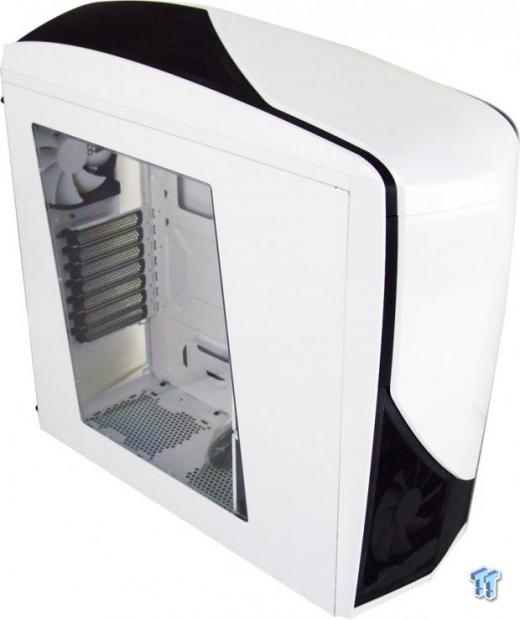
NZXT has been in the chassis game for what feels like forever as far as my career in reviewing is concerned. We have seen just about everything possible in case designs to have come from them in the past, and that history of building better and better designs is something you cannot deny NZXT at this point. NZXT is one of the select few companies that really puts thought and effort into their designs, and their latest submission is no exception.
Out of all of the case series they have come up with over this time, the most popular, and most economically beneficial to NZXT has to be the Phantom Series of cases. One major consistency over all of the Phantom cases we have seen to date, is that they are all mid-tower designs. Over our time here, we have seen them start off with an older interior design that was pretty plain and simplistic, but the Phantom series has always been known for its unusually designed exterior that really lent to losing the basic square chassis design, and gave customers a new idea of what cases could be.
As time has progressed, we have seen improvements in the features sets of these designs with new wire management ideas, new modular bay designs, and progressively offering more and more for your money. We have also seen many changes in the exterior as far as windows, ventilations, and shape of the front door, along with a few other features. This time, the Phantom series gets yet another facelift to stay current, yet it will still be a design that is easily recognized among the many previous Phantom designs.
NZXT has delivered the latest to hit their lineup in the Phantom series with this Phantom 240 mid-tower we are about to see today. While aesthetics and interior design have been improved upon, NZXT has yet to do much about the pricing, offering what has to be one of, if not the best, bang for the buck chassis yet to be offered in this series. So stick with us as we cover all aspects of the design, and discuss the pricing before we get down and dirty with this Phantom 240 mid-tower from NZXT.
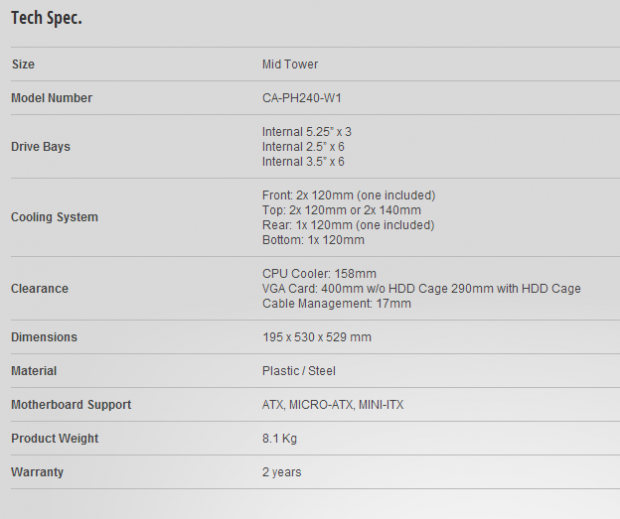
As we can see, this Phantom 240 is a mid-tower chassis, and it also goes by the part number of CA-PH240-W1. This breaks down to CA for case, PH240 for Phantom 240, and the W1 stands for its white color, which, as far as we can tell, is the only current color choice for this design. Inside of this chassis there are three 5.25" bays, followed by six drive bays that can house either a 2.5" or 3.5" drive on each tray.
As for the cooling, the front can hold two 120mm fans, but only one is supplied. The top can house a pair of 120mm or 140mm fans, but neither are supplied, the rear holds the last included 120mm fan, and there is an option to place yet another 120mm fan in the floor. Just below the cooling section, we do see that there are some limitations to this design where the CPU cooler cannot be taller than 158mm, video cards can only be 290mm in length unless the modular section of HDD rack is removed, and NZXT even offers up spacing of 17mm behind the motherboard tray.
The dimensions of this steel and plastic chassis show that this chassis is only slightly taller than it is deep, with 530mm and 529mm measurements respectively. We can also see the width is 195mm. The motherboard tray is designed to house Mini-ITX, Micro-ATX, as well as ATX motherboards, to fit most users' needs. At the bottom, we are given the dry weight of the chassis at 8.1Kg, and we also see that this chassis comes with a two-year warranty.
While we are not going to be very descriptive of the design and aesthetics at this point, it is because we feel a picture is worth a thousand words. With just a couple of glances at this design, it is easy to see the changes that have been made from previous Phantom cases we have seen thus far.
However, we will tell you that just about everywhere we usually haunt to shop for gear has this chassis available, and it is even available at some places we have never seen before. What we found is that across many locations, the pricing very near the $69.99 price point that the NZXT shop offers the chassis at. We did mention some newer locations, but in that aspect, we can see the pricing for this Phantom 240 escalating quickly up to, and over $100 in some places, which makes us realize why we stick to Amazon, Newegg, Tiger, and other places that do so much business they don't have to be a wallet killer on each and every product they sell.
Shop around, but you will be very hard pressed to find this chassis for less than $70. But who knows, if you do find a sale, you are getting a seriously good deal, as we are very willing to tell you there is plenty of value in this chassis at its current pricing.
PRICING: You can find the NZXT Phantom 240 Mid-Tower Chassis for sale below. The prices listed are valid at the time of writing but can change at any time. Click the link to see the very latest pricing for the best deal.
United States: The NZXT Phantom 240 Mid-Tower Chassis retails for $69.99 at Amazon.
Packaging
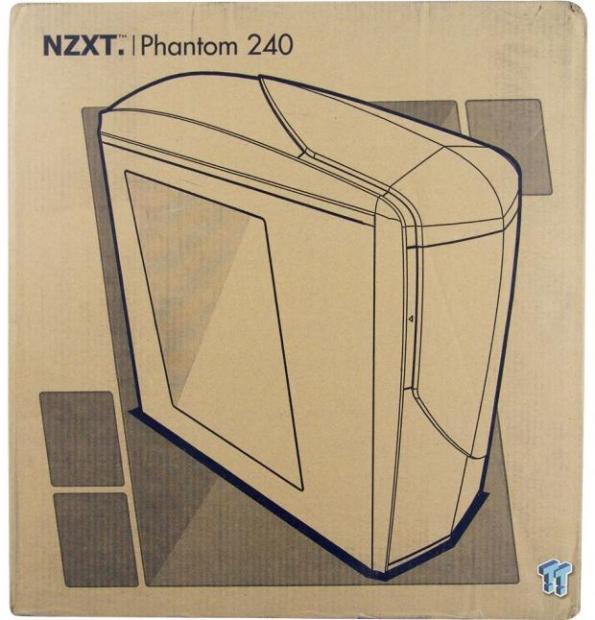
More and more often, we are seeing manufacturers putting money into the product, and not the packaging, which translates to lower cost for the customer. On plain brown cardboard, NZXT used black screening to apply the name at the top, the chassis rendering, and the angular blocks behind it that are based loosely on the shapes and angles in the chassis design.
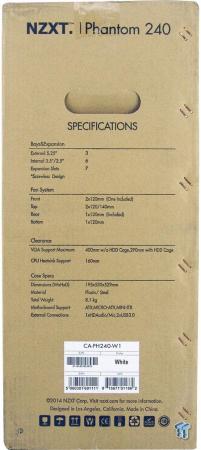
As we move around to the first side panel, we find the company and chassis naming at the top. Under the carry handle, we find the same specifications chart we just discussed; below that, we find the product sticker with the case part number, and bar codes.

Even with simple screening to apply the black ink, NZXT proves you can still convey a lot of information. Here we have a side rendering of the chassis inside, as well as four images below covering the modular bay, the front I/O contents and location, the inclusion of next-gen FN V2 120mm fans, and discussing water cooling potential.
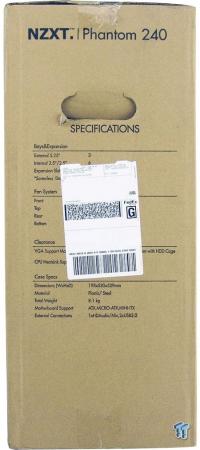
We usually complain about the lack of effort from transit companies to not muck up things with their stickers, but since this side is identical to its opposing panel, we already saw what is offered here anyways.
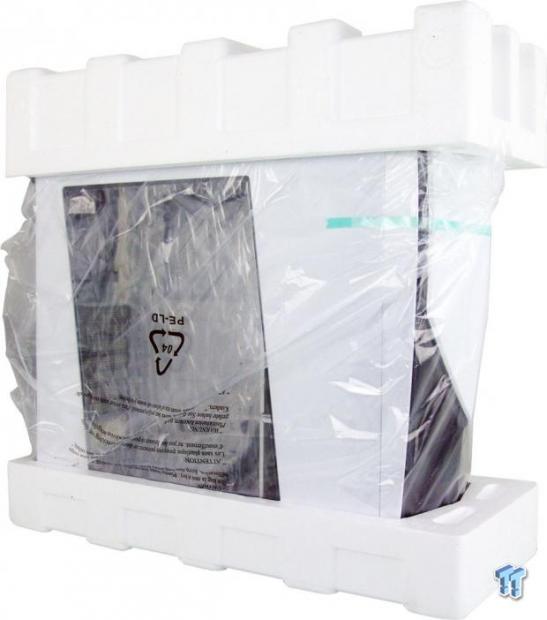
The inner packaging consists of thick Styrofoam caps used to offer the chassis the most security against damage in transit. Under that is a typical plastic liner, but even under that, there is plastic covering the entirety of the top, front, and outside of the window in the side panel.
We found it all worked very well; in fact, there was only a slight scratch on the inside of the window, but we feel it was assembled that way, as nothing inside could have hit it. Outside of that, this NZXT Phantom 240 arrived in terrific shape.
NZXT Phantom 240 Mid-Tower Chassis
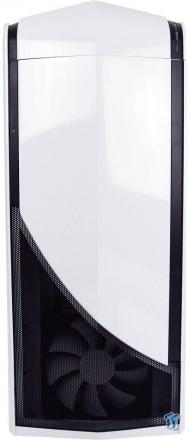
From the front, the Phantom 240 may look similar to others in the Phantom Series, with the high center line, and the angled section of mesh at the bottom. However, the profile angle has been changed here, as you will see in upcoming images. We do like the mix of shiny white along with the black accents to add a bit of style.
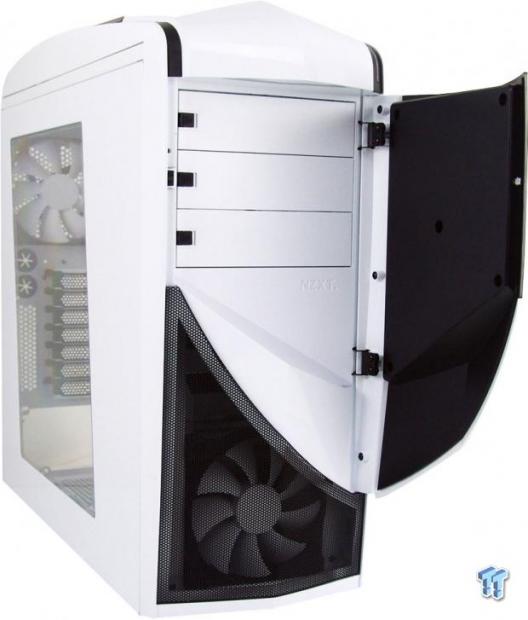
The top section of the bezel is a door that exposes the trio of 5.25" bay covers that do not require the removal of the bezel to access properly. The door itself is held in with a locking mechanism on the left edge, and will click in to lock, and you simply click it again to release it.
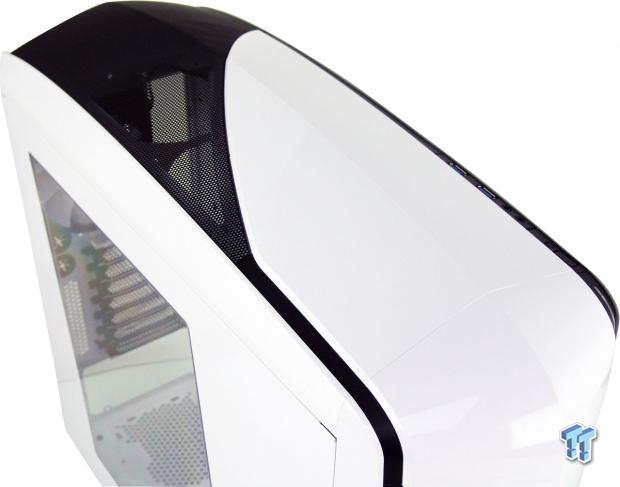
At first glance, the top of the chassis looks similar to the rest of the Phantom Series as well with its high center line and mesh section to the rear of the panel. The shape of the mesh here, as well as at the front, is new. The profile of the top has also been adjusted to make this version stand out amongst the rest of the Phantom series.
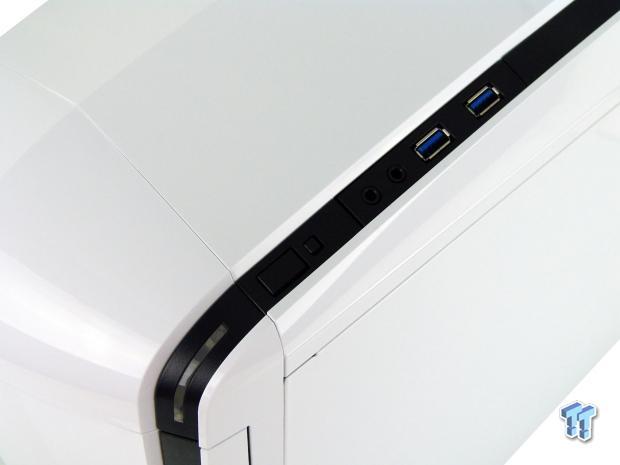
We had to spin the case around a bit to the right top edge to get a view of the front I/O panel. Here there is a light at the front edge that shows both power and HDD activity, followed by a power and reset button. There are also two 3.5mm jacks for audio support, just before running into the pair of USB 3.0 ports.
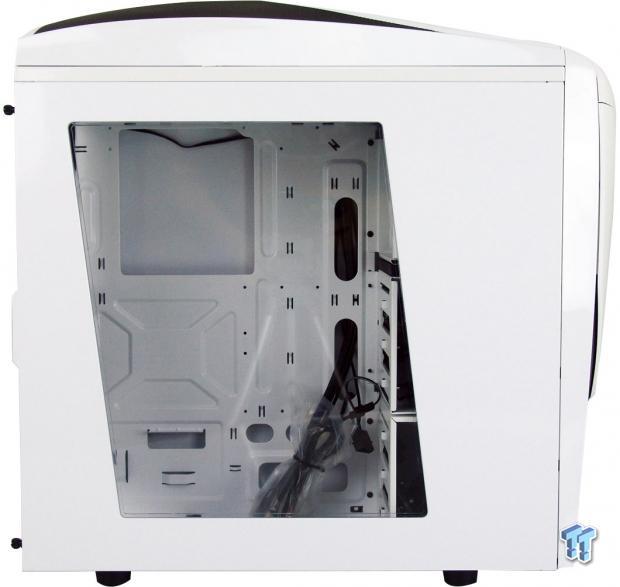
As we view the left side of the chassis, we find there is the large angled window cut into the door panel that is most obvious; but look at the way the front is curved, as well as how the top has a high point that gives this Phantom an all new look.

The back of the chassis starts with the rear I/O, and the exhaust fan location, followed by seven expansion slots, with water cooling grommets for tubing and mesh ventilation next to them. That leaves the PSU to go in the bottom.
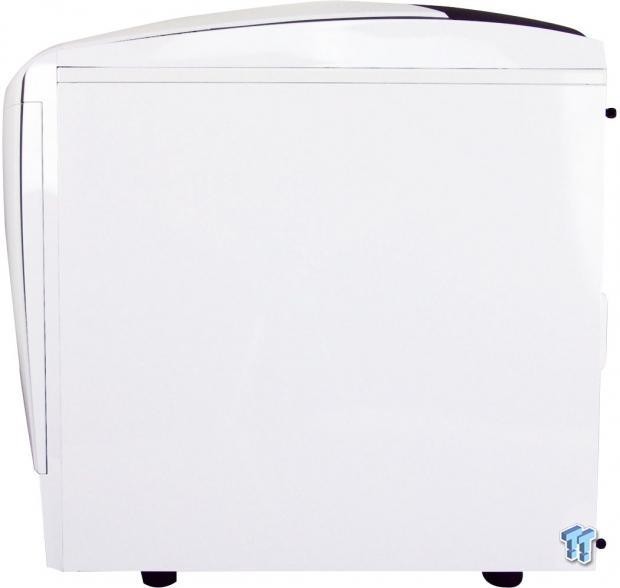
The right side of the chassis is pretty simple, with a vast expanse of steel covering this side. These doors slide on and off the chassis, and use thumbscrews with rubber washers to hold them securely to the chassis frame.
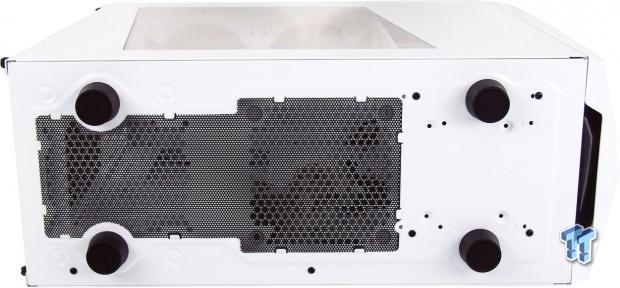
The bottom of the chassis offers round, hard rubber feet to keep the chassis off the ground. The height allows for the PSU and optional fan location to draw in cooler air through the one piece dust filter that covers both intakes.
Inside the Phantom 240
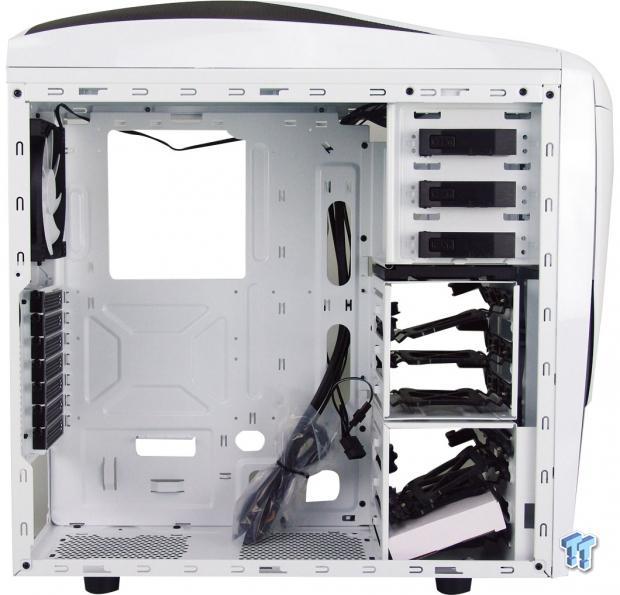
The first look inside the chassis shows us that the HDD trays must be a tad loose in their fit, as they are almost all out of whack. We also see the hardware box there, and just to the left we see the wiring is tied up well so that nothing will float free around the main section of the chassis.
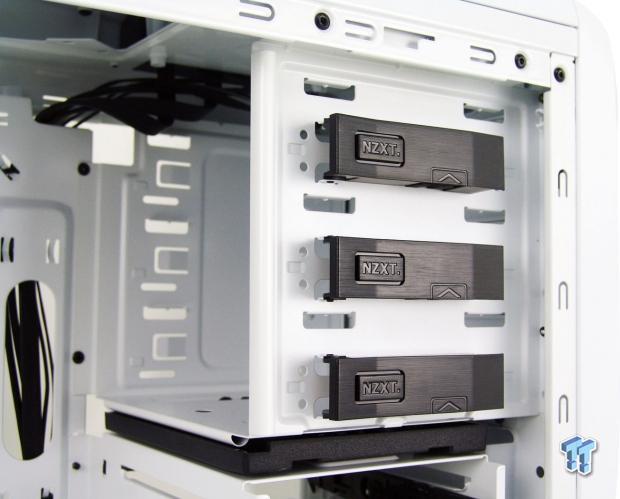
At the top, we find three 5.25" bays with some beefy tool-free mechanisms to lock the drives into place. There are also holes to allow screws from both sides, to make sure the drives can never slip past these clips.
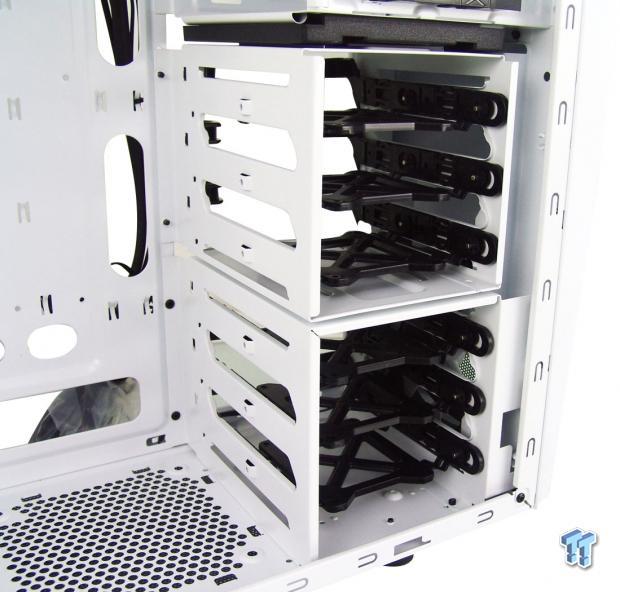
Moving down in the front of the Phantom, we find two HDD racks that can each house three drives in the black trays that slide out of the right side. These trays will of course house a 3.5" drive, but they are also designed to house a 2.5" drive in the middle of each tray.
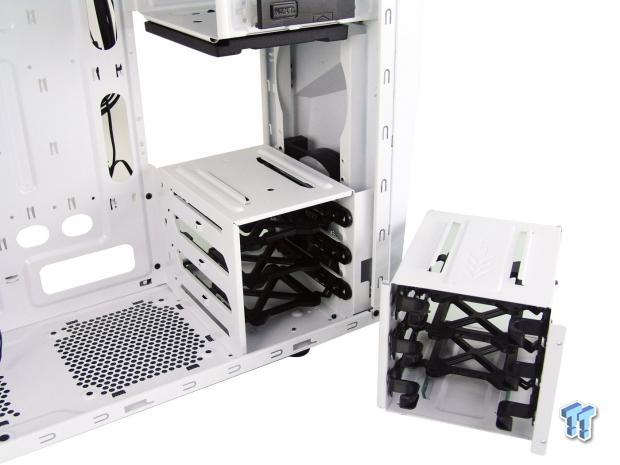
Removing a couple of screws from the right side of the chassis allows the top section of the racks to be removed to extend GPU length to 400mm, and also allow the optional fan location to push air right into the main section.
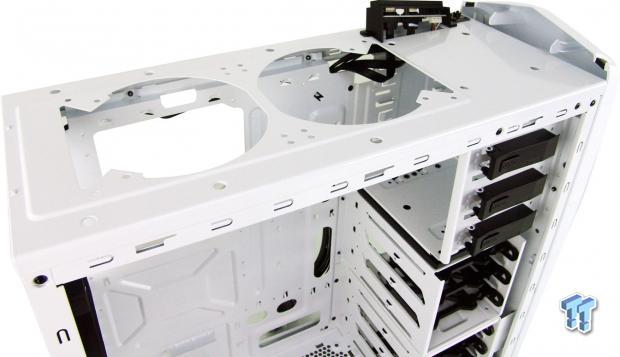
The top simply holds to the chassis with clips that allow it to be removed for access to the top panel. There are no fans supplied, but there is room for a pair of 120mm fans, or a pair of 140mm fans. We can also see the I/O panel that stays on the chassis, and allows the panel to be set aside without getting damaged.
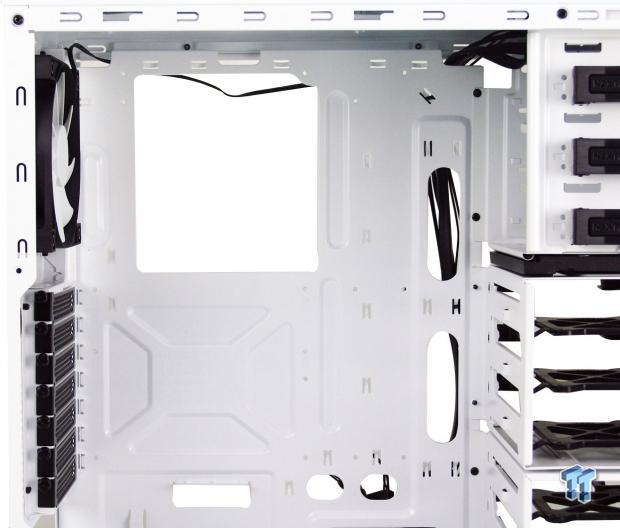
The motherboard tray is marked for the standoff installation, offers a large access hole, has seven wire management holes visible, and has nineteen tie points punched into logical locations.
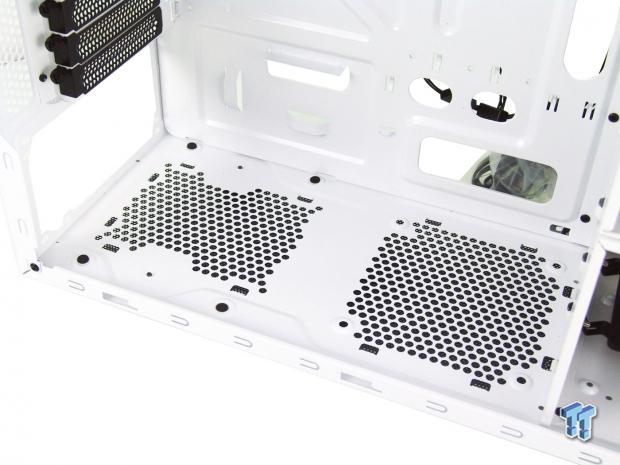
The floor of the chassis offers areas for the PSU, with little foam pads to isolate it. In front of the PSU, there is an optional 120mm fan location, and we can see the much larger wire management hole at the bottom of the tray that was not visible in the other image.
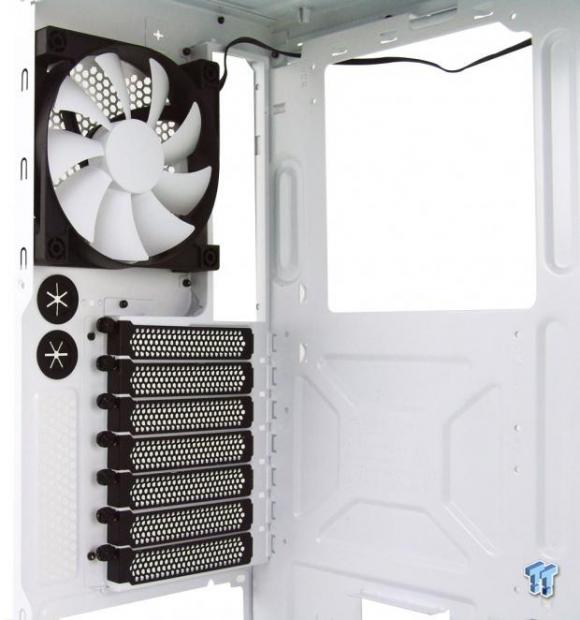
Inside of the rear of the chassis, we see the white and black 120mm fan that NZXT has placed in this chassis. We also see thumbscrews holding in the ventilated expansion slot covers on the inside of this design, which provides a change of pace from the last few we have seen.
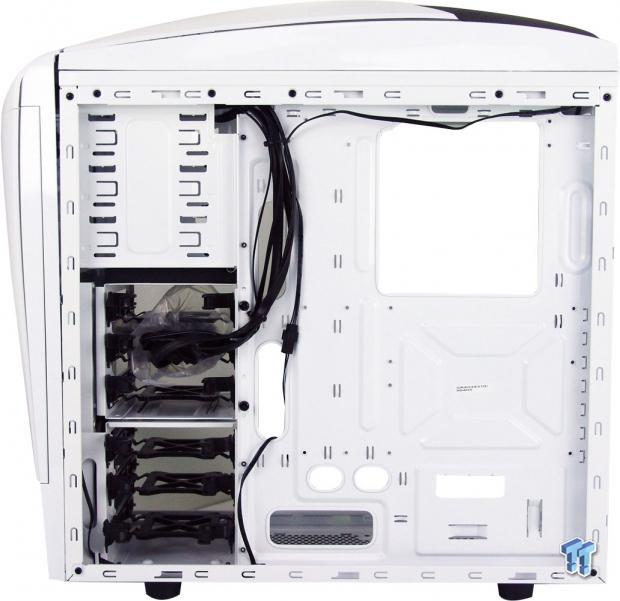
NZXT does a bit of the pre-wiring for you as they run the I/O wiring, and fan power leads. The minimum of space here is 17mm, but as you will soon see, there is plenty of room to get the job done cleanly.
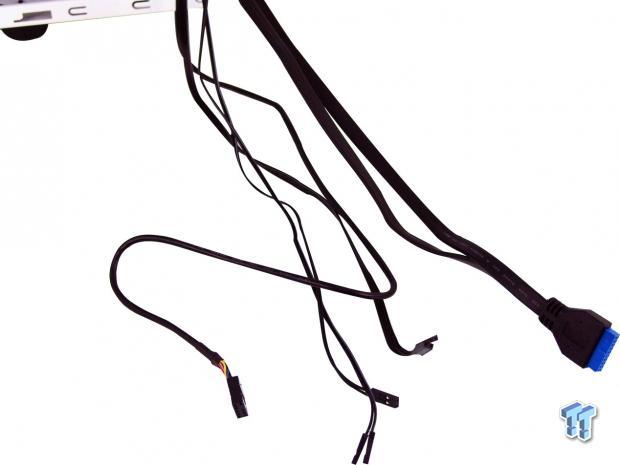
There is a Molex fan splitter cable that is installed to power the pair of fans that are not in this image, but we do see the black cables to connect the HD, Audio, front panel switches, and LEDS. We also have the native USB 3.0 connection, but no adapter for older motherboards.

Removing the front bezel shows that the mesh in the front is the dust filter for the 120mm fan they have placed in the front. We can also see that the LEDs are connected to the chassis here, allowing the bezel and the top to be set aside until they need to be placed back on the chassis.
Accessories and Documentation
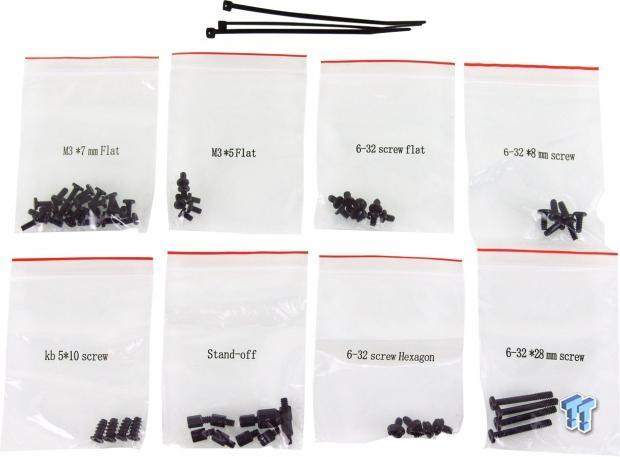
The hardware box we found in the HDD rack offers all of what you see here, along with some folded up instructions. Here we have the 2.5" drive screws, 5.25" drive screws, motherboard screws, and the HDD tray screws at the top, under the three tie straps. At the bottom, we get regular fan screws, standoffs and a socket, PSU screws, and longer screws for front fan installation.
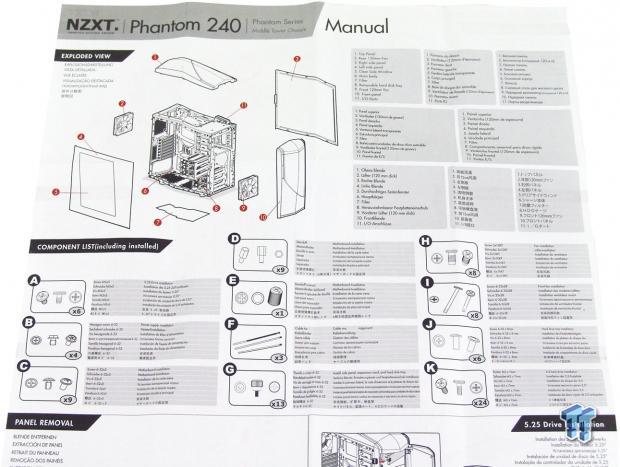
After unfolding the manual, we see it starts with an exploded view of the chassis to note all of the components, and their removal. This is followed by a parts check list to be sure everything you need is there to continue on.
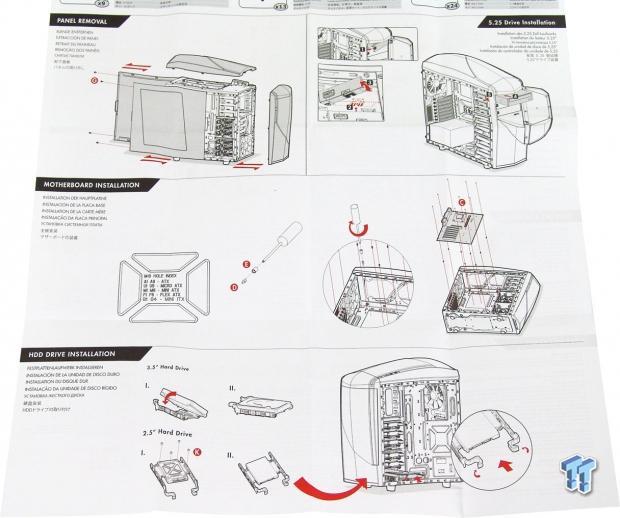
For each component needed to be installed, there is a diagram of what is being described in the short text off to top of each section. To further aid in making their points, red arrows and lines help to show what exactly needs to be done.
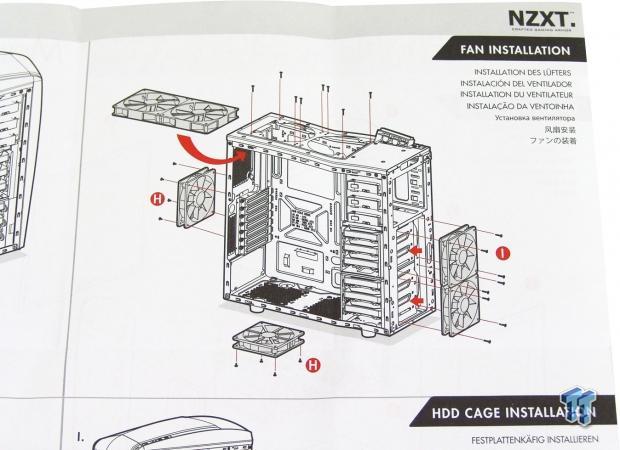
In case the cooling setup was not quite crystal clear, there is this fan diagram that shows the potential, as well as one for water cooling. Since the lower HDD rack is not removable, only the top, back, and possibly the floor, can house a radiator.
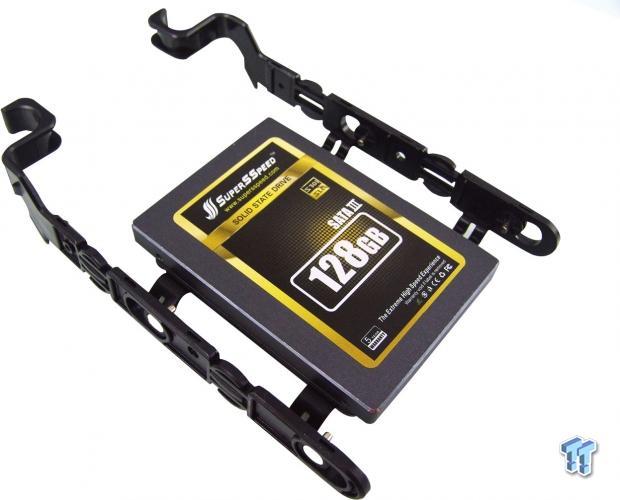
While not a huge selling point, we do like the centralized location for 2.5" drive installation in these 3.5" drive trays. This means you do not have to remove a pin, and there is no way a bit of extra plastic on the rails will impede on their installation.
Case Build and Finished Product
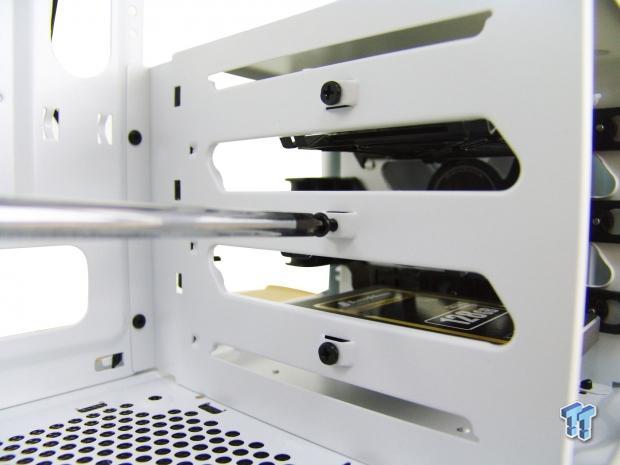
With the plastic trays so loose, and the potential for them to move around a bit even with a drive in it, NZXT has raised sections on the side with holes in them to allow users to send a screw through the metal, and it pass it into a hole in the plastic rail to keep it from sliding out.
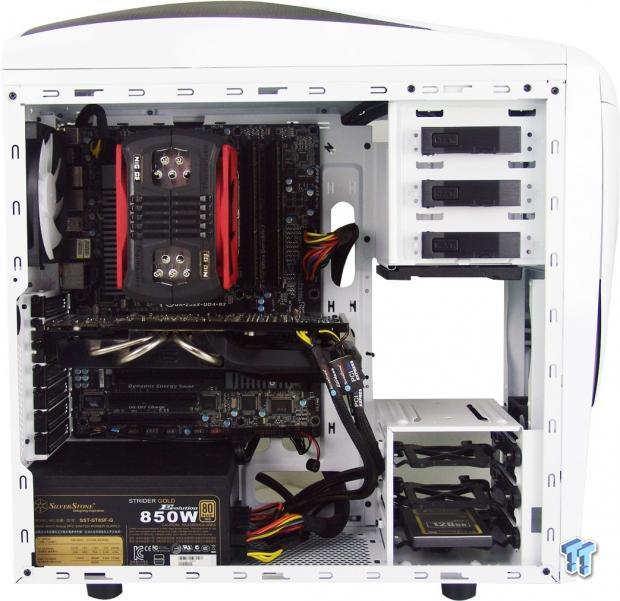
We left the HDD cage out of the chassis to show its potential for video cards, but with the fan installed in the lower position at the front, it will not free up much stock air flow. Off to the left, we find the motherboard and PSU fit well, and the Phantom 240 offers a very clean look when completed.
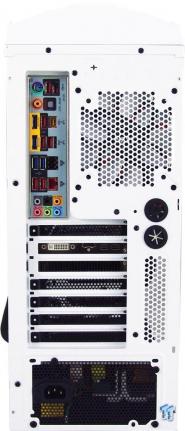
The dust shield snapped right in, the card aligns well, and it is no fuss to install with the thumbscrews. We also found the PSU slides right into place, and the holes to mount the PSU line up right on spot with the chassis holes.
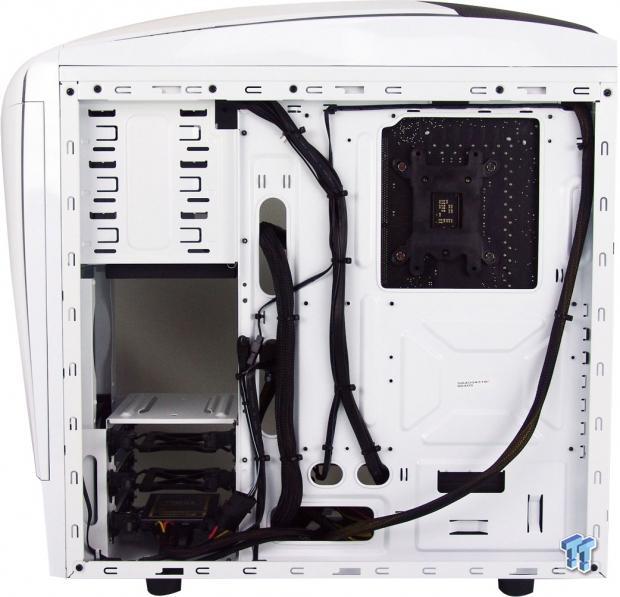
We did a bit of cleaning and re-wiring back here just to get the front I/O wiring away from the thick 24-pin lead. With all of the holes and punched out tie points, we had no issues finding a way to keep things tidy, and even with much more gear, wiring can be easily tamed in this design.
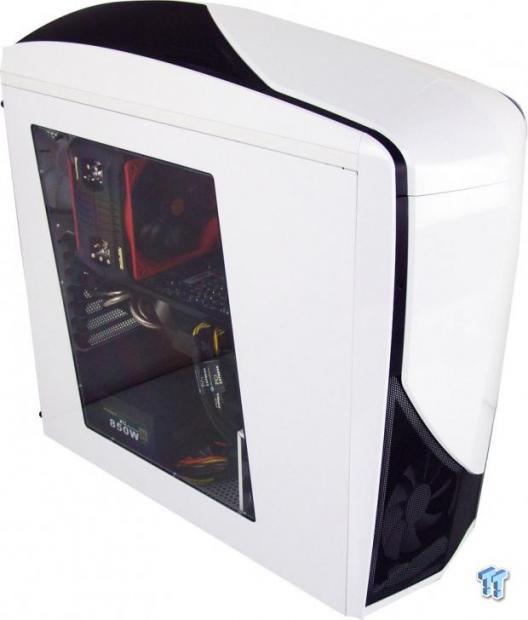
This is yet another chassis that does not change from our initial images, well, except for the view through the large window. The angular design shows just a hint of the lower drive bays, but it definitely affords a great view of all of your installed goodies.
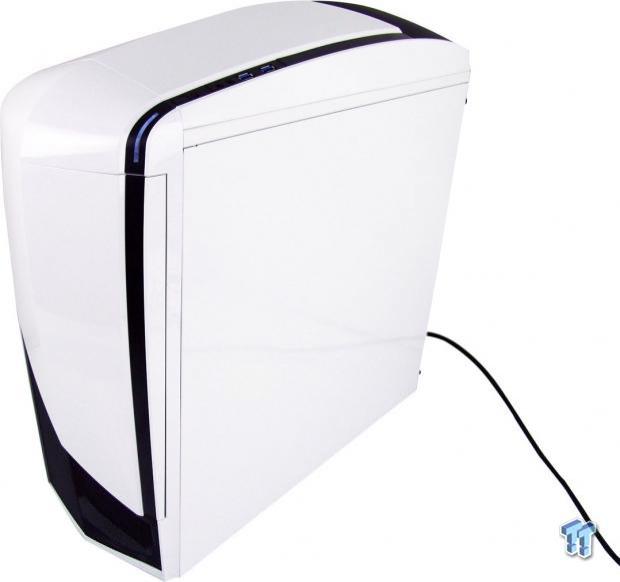
Once we powered up the Phantom 240, if not for the white LED, and the occasional flicker of the HDD activity LED, we would find it tough to tell it was running. The fans deliver 31 dB of noise at one foots' distance from the back, but are nearly inaudible behind the panel and mesh of the front.
Final Thoughts
What we really like about this latest Phantom chassis is that even being the fourth or fifth version of a Phantom we have seen so far, it still stands out amongst its brethren. With enough of the styling from the original design to show this is a Phantom chassis at just a quick glance, we appreciated the newer rounded styling, as well as the changes made inside. We also liked the ease in which everything installs, and the cleanliness in which everything is able to be wired. When all was said and done, we were left with a finished product that is a real treat to view through the chassis' large window.
If this design kicks off, and the market takes to it as we think it will, we hope to eventually see it in color choices other than white, as NZXT does tend to offer more options later in the lives of their products. Other than having more color choices, we also would have liked to see a USB 2.0 adapter for users of older systems to take full advantage of this design.
We also still haven't sorted out how those rub marks got on the inside of the window. Outside of those very small issues, there really is nothing to knock this design down a peg for. NZXT simply proves that little things can make all the difference, and keep an older series of cases relevant in today's market.
At its current pricing, we feel the Phantom 240 is worth every penny of the near $70 investment. Compared to something like the slightly more expensive Shadow from BitFenix, you are getting much more chassis for your dollar in this newest Phantom. The Phantom 240 offers everything you need in a mid-tower chassis, delivers new aesthetics while keeping its heritage intact, and even though the stock cooling is not so great, there are plenty of options left to change that to suit your needs.
If you were ever a fan of the Phantom, and for some reason never got on the train, now would be a great time to reconsider that idea, as we have seen the Phantom 240 is one of the most refined designs offered yet.
PRICING: You can find the NZXT Phantom 240 Mid-Tower Chassis for sale below. The prices listed are valid at the time of writing but can change at any time. Click the link to see the very latest pricing for the best deal.
United States: The NZXT Phantom 240 Mid-Tower Chassis retails for $69.99 at Amazon.


